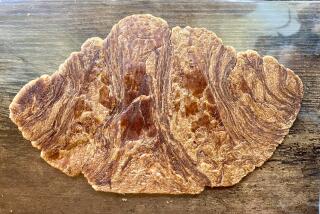Getting rough with puff pastry
- Share via
One of the things that keeps me excited about what I do is that I am always learning.
When I was making puff pastry not long ago, someone asked me why I made a tic-tac-toe-like slash in the process of making the dough. I had been slashing puff pastry dough, and having my chefs do it, for 30 years, or for as long as I’d been making puff pastry, and yet I had no idea why. I was thinking about this during a drive down to Pizzeria Mozza in Newport Beach. Then, just when I got out of the car, like magic, there was the renowned French baker Claude Koeberle. “You’re just the man I want to see!” I told him. I asked him my question about slashing, which led to a long discourse about butter and oven temperatures and other details too esoteric to go into.
And then, just to prove it’s never too late to teach an old dog new tricks, when I told Claude that at Osteria Mozza we used puff pastry to make borsellini, or beggar’s purses, filled with spiced roasted apples, he told me that for this dessert, I shouldn’t be using true puff pastry at all; that for anything filled, I should use what’s known as “rough puff.”
More Master Class stories and recipes
This was news to me. But if this were true, which, Claude being Claude, I assumed it was, this was great news for home cooks as well. Making classic puff pastry is extremely time consuming and precise; especially if you’ve never done it before, many things can go wrong.
Now that there are packaged alternatives made with real butter, unless you are a cooking Olympian who enjoys a challenge for its own sake or wants the bragging rights of being able to say you’ve made something that nobody in their right mind has ever made from scratch unless they are being paid to, there is no reason to make classic puff pastry at home.
But rough puff is a different story.
To make classic puff pastry, you start with the détrempe, which is a basic dough made of flour, water and butter, and into that you cut a lot more butter. The layers that give puff pastry the name pâte feuilletée, or “layered pastry” in French, are created by a process called “turning the dough,” whereby after adding the second dose of butter, you roll out the dough, fold it into thirds, roll it out again, fold it again … and on it goes until you’ve made a total of four or more turns.
Rough puff is made using the same ingredients and the same turning method as in classic puff pastry. The difference is that with classic puff pastry, the butter is molded into a large rectangle of a specific size and shape and integrated into the détrempe in a very precise and symmetrical way. With rough puff, the butter is cut into big chunks and integrated into the détrempe in a random way, resulting in a much easier, less time-consuming process.
When I learned to make puff pastry while I was a student at Le Cordon Bleu in London, they taught rough puff as a lazy man’s (or woman’s) alternative to the classic version. Since then, I’ve always insisted that if I were going to make puff pastry, it had to be “the right way.” Now, all these years later, here I was, standing with a true authority being told that rough puff wasn’t an inferior option, it was simply a different dough, and in fact it was the dough that for filled pastries would yield the superior product.
Of course, the first thing I did when I got back to the Osteria was set out to try our borsellini using puff pastry made Claude’s way. This meant not only using rough puff but also using milk in place of half the water used in classic puff pastry, a tip Claude reminded me that Paris pastry chef Pierre Hermé used for both flavor and color.
Together with my pastry chefs, I made several versions of rough puff, playing with different amounts of milk, butter and salt. The end result was as light, crisp, flaky, flavorful and golden brown as I could ever hope a puff pastry would be — and as Claude promised, even better than the classic one I had been using.
My puff pastry world had officially been rocked, and though you didn’t even know it then, if you’re a fan of making or eating puff pastry, yours was too.
I almost forgot to tell you: Claude explained to me that the reason we slash the détrempe is that it helps the dough to relax, which makes it easier to work with. A fitting parallel.
More to Read
Eat your way across L.A.
Get our weekly Tasting Notes newsletter for reviews, news and more.
You may occasionally receive promotional content from the Los Angeles Times.









